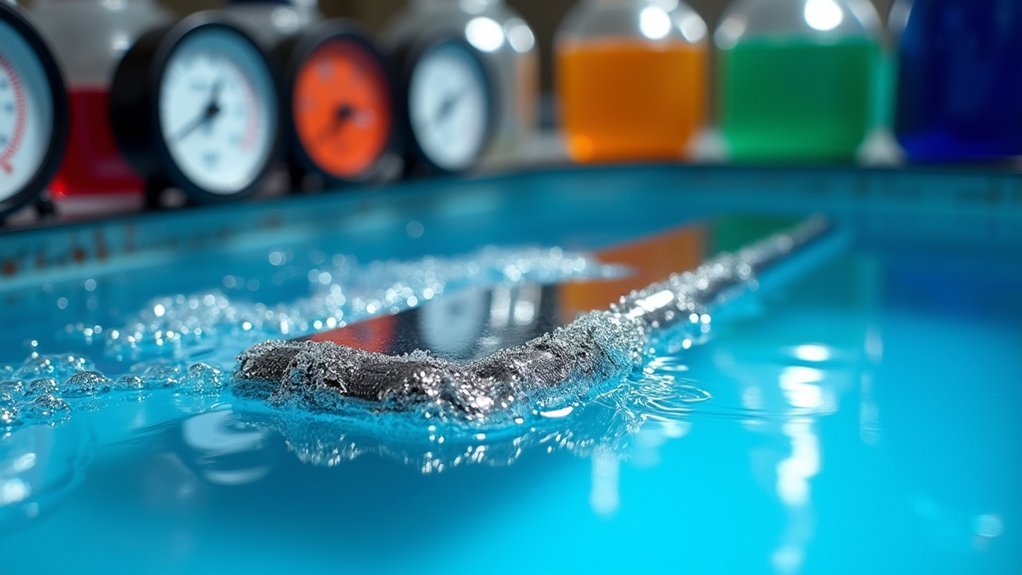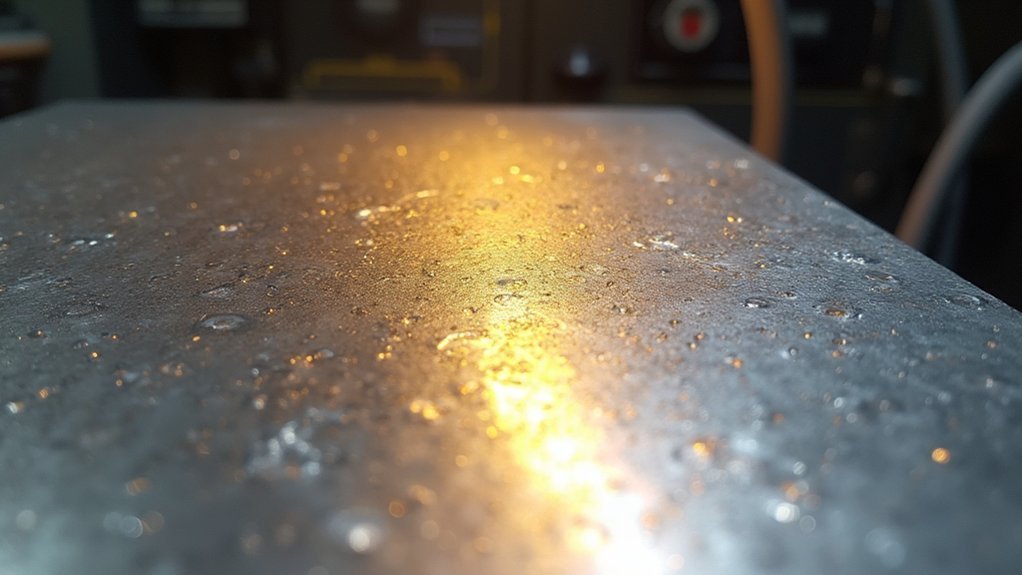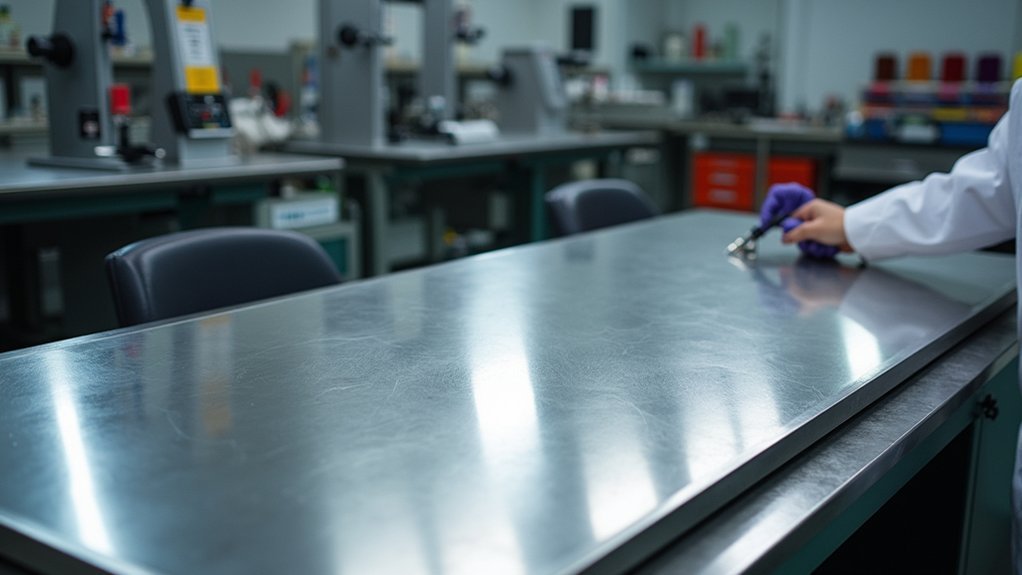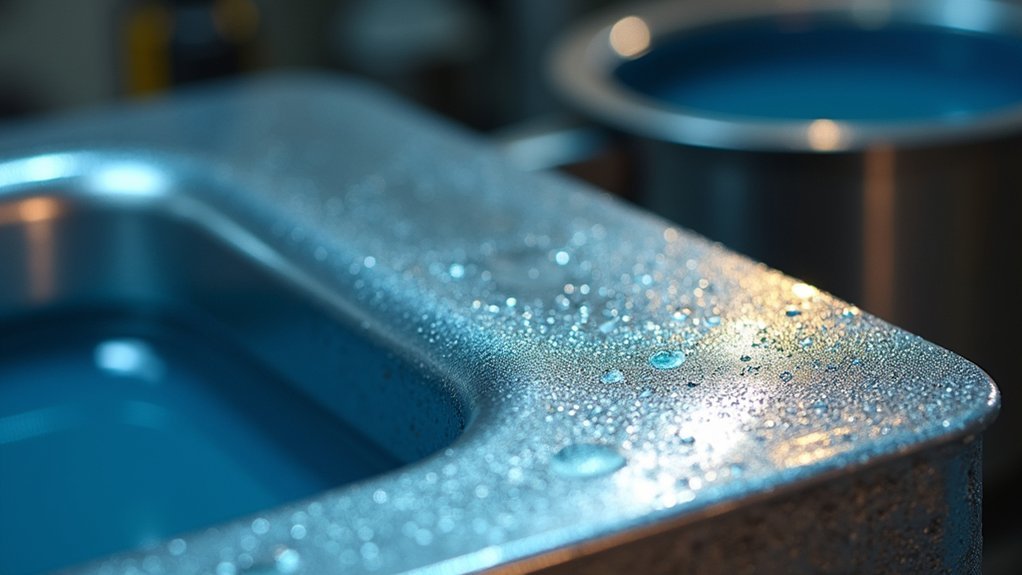You’ll achieve professional electroplating results by maintaining ideal bath chemistry with pH levels between 20-30°C, thoroughly cleaning surfaces to remove all contaminants, selecting current density of 1-10 A/dm² for uniform coverage, choosing compatible base materials like steel or aluminum alloys, controlling plating thickness through precise timing, positioning parts properly on racks for even distribution, and implementing regular quality testing protocols including thickness measurements and adhesion strength validation. Master these fundamentals to access advanced techniques that separate exceptional finishers from average operators.
Maintain Optimal Bath Chemistry and Temperature Control

While temperature fluctuations and chemical imbalances can destroy your electroplating results, you’ll achieve consistent, high-quality deposits by maintaining precise control over your bath chemistry and operating conditions.
Monitor your pH levels and metal ion concentrations regularly to prevent dull or rough deposits that compromise plating quality. Keep your bath temperature between 20°C and 30°C using heaters or chillers, as deviations notably impact your deposition rate and coating uniformity.
Regular monitoring of pH levels and metal concentrations prevents dull deposits while proper temperature control ensures uniform coating quality.
Check your electrolyte frequently for contaminants and adjust additives to prevent pitting and adhesion loss. Use a precise power supply with consistent output to maintain stable current density across your substrate.
Proper temperature control systems guarantee ideal deposition rates and overall plating success.
Ensure Thorough Surface Preparation and Cleaning
Success in electroplating depends fundamentally on achieving pristine surface conditions before applying any coating. You’ll need to remove all contaminants like oils, coolants, and oxidation that compromise adhesion and create defects in your electroplated layer.
Start with thorough disassembly, stripping, and polishing to create an active surface ready for metal coating. This preparation guarantees uniform coverage and prevents flaking or blistering. Choose your cleaning agents carefully—organic oils are easier to remove than silicon-based alternatives.
After cleaning, conduct meticulous inspection to identify remaining particles or surface defects that could hinder electroplating. Don’t skip this critical step.
Consistent application of these preparation practices greatly reduces common pre-coating problems like pitting and adhesion loss, delivering superior finished products.
Select the Right Current Density for Uniform Coverage

Current density serves as the primary control mechanism for achieving uniform electroplating coverage across your workpiece.
You’ll need to select the ideal range of 1 to 10 A/dm², depending on your specific metal and electrolyte composition. Too high electrical charge creates uneven deposits, pitting, and rough surfaces that compromise coating quality.
Monitor your current density throughout the electroplating process, as bath temperature and metal ion concentration changes affect deposition rates.
Consistent density prevents edge buildup at corners and maintains even plating thickness across surfaces.
Calibrate your power supply regularly and follow manufacturer specifications to enhance adhesion and achieve superior metal finishes.
These practices guarantee controlled deposition rates and minimize defects that can ruin your final coating quality.
Choose Compatible Base Materials and Plating Metals
Material compatibility determines the success of your electroplating project from the start. You’ll need conductive substrates like metals or specialized conductive plastics for ideal electroplating results.
When selecting compatible base materials, consider steel and aluminum alloys that work well with common plating metals such as nickel, gold, and chrome.
Your choice of alloys like brass or stainless steel can greatly improve adhesion and durability due to their superior electrochemical characteristics compared to pure metals.
You must also match thermal and mechanical properties between your base material and plating metal to prevent stress fractures or delamination.
- Clean all surface contaminants thoroughly before plating to guarantee proper bonding
- Match thermal expansion rates between base and plating materials
- Test electrochemical compatibility with small samples first
Control Plating Thickness Through Timing and Monitoring

While achieving the right plating thickness requires precision, you’ll find that timing and monitoring are your most reliable tools for consistent results.
Control your electroplating thickness by adjusting the plating process duration, typically ranging from 5 to 45 minutes depending on your desired specifications and metal type.
Monitor current density carefully throughout the process, as higher densities create uneven thickness and poor adhesion. Maintain consistent voltage for uniform results.
Regularly test your plating bath’s composition and temperature, since deviations directly impact deposition rates and overall quality.
Use a micrometer or similar measuring tool post-plating to verify thickness accuracy.
Implement systematic documentation of each cycle for effective quality control. This approach helps you identify trends and continuously improve your electroplating processes for enhanced consistency.
Implement Proper Rack Positioning and Part Orientation
Although timing controls your plating duration, your rack positioning and part orientation determine whether that time produces uniform results across every surface.
Proper rack positioning guarantees even current distribution, while strategic part orientation promotes uniform metal deposition across all areas.
Position larger surfaces perpendicular to anodes to minimize corner buildup and achieve consistent thickness. Your plating solution must reach every surface effectively, so maintain adequate spacing between parts to prevent shadowing effects.
- Space parts properly – Avoid overcrowding to prevent electroplating defects like pitting and poor adhesion
- Orient strategically – Position large surfaces perpendicular to anodes for ideal current flow
- Inspect regularly – Adjust positioning based on part geometry to maintain consistency of electroplating results
Don’t stack components or create tight clusters that block solution access.
Conduct Regular Quality Testing and Process Validation

You’ll maintain consistent electroplating quality by establishing regular testing protocols that monitor your process at critical control points.
Start by testing your bath chemistry frequently to catch contamination or imbalances before they affect your parts.
You should also measure coating thickness and validate adhesion strength to guarantee your finished products meet specifications.
Test Bath Chemistry
Three critical parameters form the foundation of successful electroplating: pH levels, metal ion concentrations, and temperature control.
You’ll need to test bath chemistry regularly to maintain your electrolyte solution’s effectiveness. When these parameters drift from ideal ranges, you’ll notice dull or hazy deposits on your finished parts.
Monitor your electroplating process through systematic quality testing. Use titration methods to quantify metal ion concentrations accurately, ensuring your bath maintains the desired composition.
Don’t forget to check your rectifier function and current density, as these directly impact coating uniformity.
- Monitor pH levels, metal ion concentrations, and temperature consistently
- Use titration methods to measure key metal ions in your electrolyte solution
- Perform routine checks on rectifier function and current density for ideal results
Monitor Coating Thickness
Consistent coating thickness measurements serve as your primary defense against electroplating failures and quality issues.
You’ll need micrometers or thickness gauges to capture accurate measurement data at multiple points across each part. This thorough monitoring approach guarantees your electroplated layers meet specifications consistently.
Establish a quality control schedule that includes periodic testing of production samples. You can’t rely on spot checks alone—systematic validation keeps your plating processes within acceptable tolerances.
Implement statistical process control techniques to track coating thickness variations over time, enabling early detection of potential problems.
Document every measurement and finding to maintain compliance with industry standards. This data becomes invaluable for process improvements and troubleshooting future issues in your electroplating operations.
Validate Adhesion Strength
While thickness measurements provide essential data, adhesion strength testing reveals whether your electroplated coatings will actually stay attached during real-world use.
You’ll need systematic quality assurance protocols that combine multiple testing approaches to validate coating performance.
Implement quantitative adhesion tests like the cross-hatch method to generate measurable adhesion strength data. Monitor plating thickness and uniformity during process validation to catch defects before they compromise coating integrity.
Conduct thorough inspection of surfaces before and after plating to identify contamination that could cause adhesion failures.
- Cross-hatch adhesion tests provide quantifiable data on coating bond strength for quality documentation
- Pre and post-plating surface inspection catches contamination issues that lead to premature coating failure
- Advanced SEM analysis reveals micro-level adhesion characteristics for improved process optimization
Frequently Asked Questions
How to Achieve Good Electroplating?
You’ll achieve good electroplating by thoroughly cleaning parts, optimizing component design with rounded edges, using proper pre-treatment processes, controlling plating parameters like current density and temperature, and conducting regular quality inspections.
How to Increase the Rate of Electroplating?
You can increase electroplating rates by raising current density and electrolyte temperature, improving bath agitation, maintaining balanced ion concentrations, and ensuring proper substrate preparation. Monitor carefully to avoid defects from excessive parameters.
Is 12 Volts Too Much for Electroplating?
Twelve volts isn’t necessarily too much for electroplating, but you’ll risk rough, uneven deposits if you don’t carefully control your bath temperature, concentration, and agitation to maintain quality.
Why Is My Electroplating Not Working?
You’re likely experiencing poor surface preparation, incorrect bath chemistry, or wrong current density. Check if you’ve properly cleaned the part, balanced your electrolyte solution, and aren’t using excessive voltage.
In Summary
You’ll achieve superior electroplating results when you master these seven fundamental practices. Don’t overlook any single element—each tip builds upon the others to create a robust finishing process. Whether you’re plating decorative chrome or functional zinc, consistency in bath chemistry, surface prep, and process control determines your success. Monitor your results closely, adjust parameters as needed, and you’ll produce high-quality finishes that meet specifications every time.





Leave a Reply